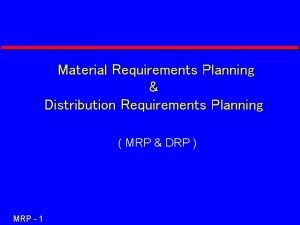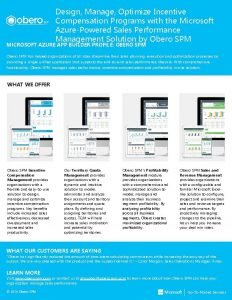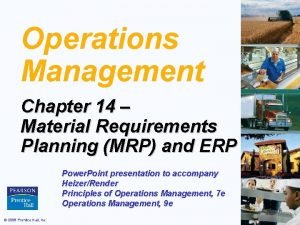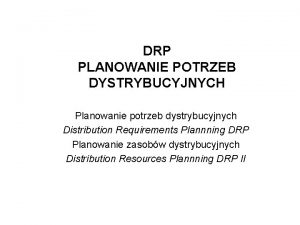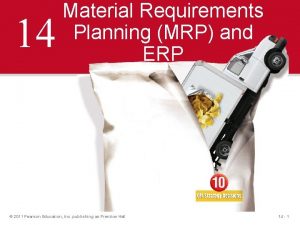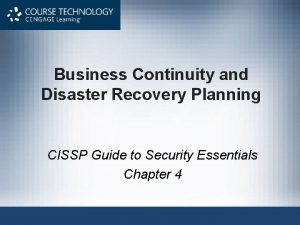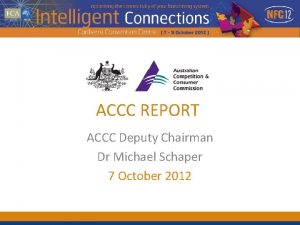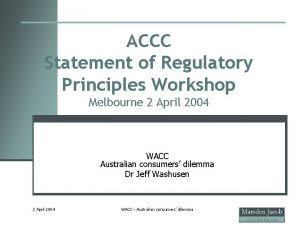ACCC Workshop on the DRP Incentive Mechanisms and












- Slides: 12

ACCC Workshop on the DRP Incentive Mechanisms and Benchmarking 1

Structure of presentation • Observations on ACCC proposals on efficiency incentives and benefit sharing mechanisms • Proposed framework for assessing the most appropriate expenditure benchmarking approach • Way forward 2

ACCC Incentive Mechanism — Observations • Based on the ESC Scheme in Victoria developed for use on distribution companies expenditure. • Proposed incentive scheme seems a reasonable starting point for opex: – Delivers even incentives over time; – Simple to apply and administer; – Reasonable sharing ratios; and – Similar schemes successfully in operation elsewhere. 3

ACCC Incentive Mechanism — Observations • TNSP expenditures are more volatile (lumpy) than distribution expenditures • No reason is put forward for the less generous proposed treatment of capex efficiencies • For the successful implementation of a such a scheme for TNSPs the sharing mechanism itself will not be the key determinant • Rather, it will depend on how the benchmark for expenditure is set in the current period and in future periods 4

Framework for Suitable Benchmark Technique • Two important considerations when considering how to set expenditures for a regulated business • Degree of predictability with-in a 5 -year reset period – Types of cost exposures can be predictable or unpredictable with-in the reset period • Degree of variability from reset to reset – The quantum of expenditure can be variable or stable (including a consistent trend) from one five year period to the next (therefore, allows averaging of annual variability) 5

Expenditure characteristics matrix Unpredictable but Stable Unpredictable and Variable Predictable and Stable Predictable but Variable 6

Assessment of Expenditure in Framework • Types of expenditures can be assessed against these two factors and placed in one of the quadrants. For example: – Planned maintenance of the transmission network tends to be both highly predictable and stable from reset to reset; – Unplanned maintenance is, by its nature, unpredictable, however, is also relatively stable when averaged over a five year period; and – Replacement Capex is predictable for a given five year period , however, it is highly variable from one five year period to the next 7

How does this help? • By placing an expenditure type in its appropriate quadrant the TNSP and Regulator can strike a regulatory bargain on how expenditures are to be set both with-in the regulatory period and in future regulatory periods • This is helped by the fact that there is some broad agreement on the appropriate treatment to be used in each quadrant • This allows a reduction of regulatory risk by helping minimise arguments at the next revenue review 8

Setting ACCC Benchmarks (1) Unpredictable but Stable Unpredictable and Variable Predictable and Stable Predictable but Variable • Suitable for benchmarking against historical expenditure and possibly long term against industry averages 9

Setting ACCC Benchmarks (2) Unpredictable but Stable Unpredictable and Variable Predictable and Stable Predictable but Variable • Need for ex-ante review to set benchmarks for each reset period 10

Setting ACCC Benchmarks (3) Unpredictable but Stable Unpredictable and Variable Predictable and Stable Predictable but Variable • Should be excluded from the cap in case of capex • Should be handled via pass-through in case of opex 11

Possible Way Forward • This frame work allows this issue to separated into two questions: • What type of benchmark or revenue setting mechanism is appropriate for each quadrant? • What types of expenditure belongs in which quadrant? 12
 Net requirement planning
Net requirement planning Obero spm
Obero spm Emerson plan formula
Emerson plan formula Individual incentive plans advantages and disadvantages
Individual incentive plans advantages and disadvantages Material requirement planning
Material requirement planning Drp ideas
Drp ideas Planowanie potrzeb dystrybucji
Planowanie potrzeb dystrybucji Bcp vs drp cissp
Bcp vs drp cissp Bia drp
Bia drp Bia drp
Bia drp Drp distribution resource planning
Drp distribution resource planning Drp adalah
Drp adalah Cissp business continuity and disaster recovery planning
Cissp business continuity and disaster recovery planning
